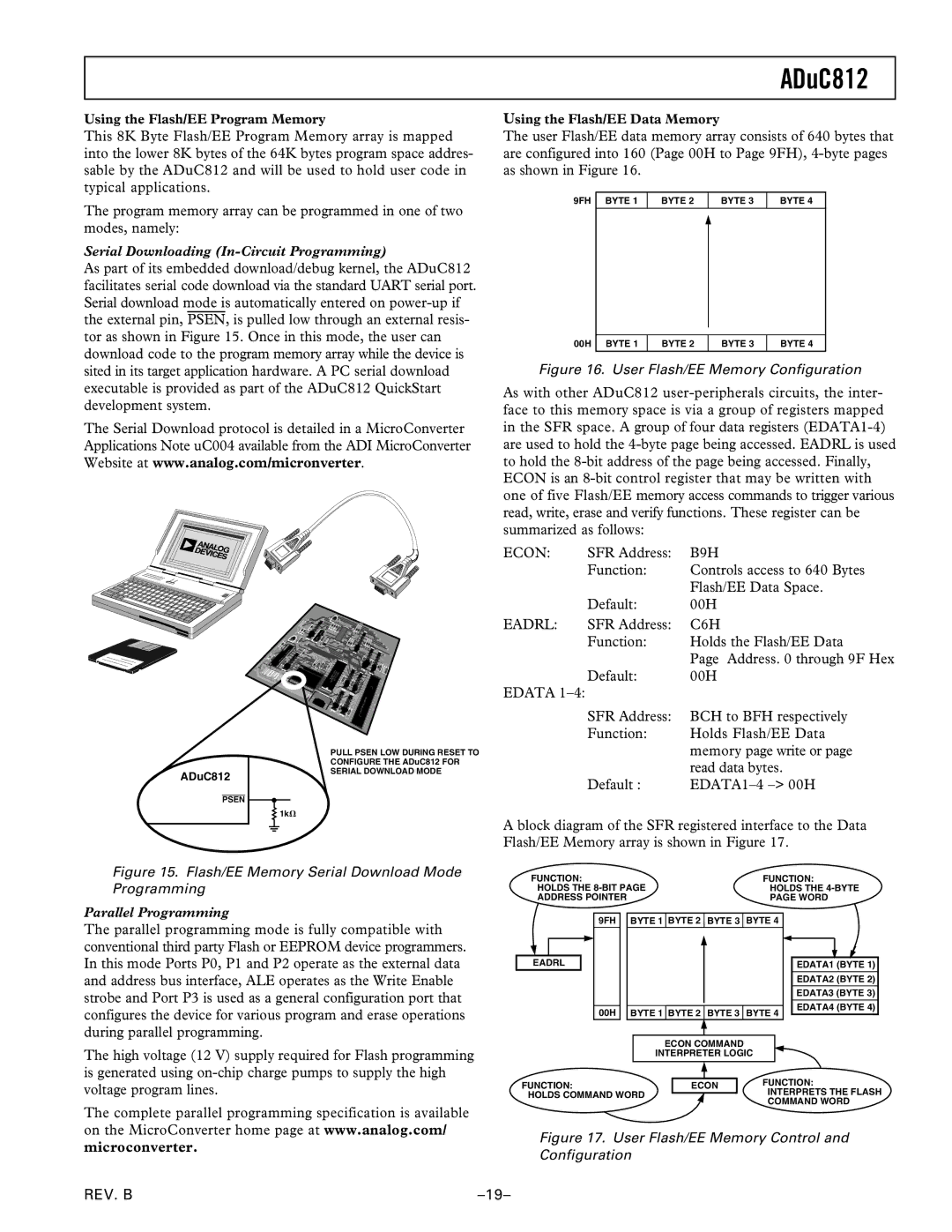
ADuC812
Using the Flash/EE Program Memory
This 8K Byte Flash/EE Program Memory array is mapped into the lower 8K bytes of the 64K bytes program space addres- sable by the ADuC812 and will be used to hold user code in typical applications.
The program memory array can be programmed in one of two modes, namely:
Serial Downloading
As part of its embedded download/debug kernel, the ADuC812 facilitates serial code download via the standard UART serial port. Serial download mode is automatically entered on
The Serial Download protocol is detailed in a MicroConverter Applications Note uC004 available from the ADI MicroConverter Website at www.analog.com/micronverter.
Using the Flash/EE Data Memory
The user Flash/EE data memory array consists of 640 bytes that are configured into 160 (Page 00H to Page 9FH),
|
|
|
|
|
9FH BYTE 1 | BYTE 2 | BYTE 3 | BYTE 4 | |
|
|
|
|
|
|
|
|
|
|
00H BYTE 1 | BYTE 2 | BYTE 3 | BYTE 4 | |
|
|
|
|
|
Figure 16. User Flash/EE Memory Configuration
As with other ADuC812
ADuC812
PULL PSEN LOW DURING RESET TO CONFIGURE THE ADuC812 FOR SERIAL DOWNLOAD MODE
ECON: | SFR Address: | B9H |
| Function: | Controls access to 640 Bytes |
|
| Flash/EE Data Space. |
| Default: | 00H |
EADRL: | SFR Address: | C6H |
| Function: | Holds the Flash/EE Data |
|
| Page Address. 0 through 9F Hex |
| Default: | 00H |
EDATA |
|
|
| SFR Address: | BCH to BFH respectively |
| Function: | Holds Flash/EE Data |
|
| memory page write or page |
|
| read data bytes. |
| Default : |
PSEN
![]() 1k
1k
Figure 15. Flash/EE Memory Serial Download Mode Programming
Parallel Programming
A block diagram of the SFR registered interface to the Data Flash/EE Memory array is shown in Figure 17.
FUNCTION: | FUNCTION: |
HOLDS THE | HOLDS THE |
ADDRESS POINTER | PAGE WORD |
The parallel programming mode is fully compatible with conventional third party Flash or EEPROM device programmers. In this mode Ports P0, P1 and P2 operate as the external data and address bus interface, ALE operates as the Write Enable strobe and Port P3 is used as a general configuration port that configures the device for various program and erase operations during parallel programming.
The high voltage (12 V) supply required for Flash programming is generated using
EADRL
9FH
00H
BYTE 1 BYTE 2![]() BYTE 3 BYTE 4
BYTE 3 BYTE 4
BYTE 1 BYTE 2 BYTE 3 BYTE 4
ECON COMMAND
INTERPRETER LOGIC
EDATA1 (BYTE 1)
EDATA2 (BYTE 2)
EDATA3 (BYTE 3)
EDATA4 (BYTE 4)
voltage program lines.
The complete parallel programming specification is available on the MicroConverter home page at www.analog.com/ microconverter.
FUNCTION: | ECON | FUNCTION: |
HOLDS COMMAND WORD |
| INTERPRETS THE FLASH |
|
| COMMAND WORD |
Figure 17. User Flash/EE Memory Control and Configuration
REV. B |
